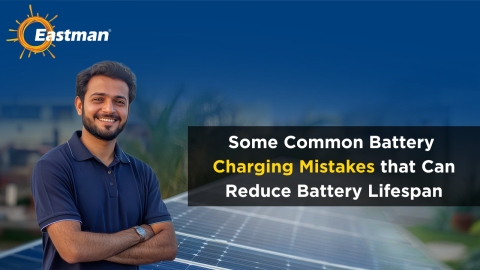
Debunked! 6 Inverter Battery Myths You Should Stop Believing
Myths have a way of creeping into our lives, often disguising themselves as truths. In the case of an inverter with battery for home, these myths can lead us down a path of confusion and costly misconceptions.
Myths typically, sprout from misunderstandings, hearsay, and sometimes, sheer misinformation. And they can affect how we choose and maintain our inverter batteries, impacting our daily lives and, sometimes, our wallets.
In this article, we'll break down these myths. We will reveal the reality behind each one. So, if you're ready to separate fact from fiction and make informed decisions about your inverter battery, let's dive in!
I. Debunking 5 Inverter Battery Myths
1. Completely Discharging the battery harms the inverter
Reality: Complete Battery Discharge is A-OK!
It's a common belief that allowing your inverter battery to reach a complete discharge is detrimental to both the battery's performance and the inverter itself. However, this notion is more myth than reality.
In reality, modern inverter batteries, especially those of the lead-acid or lithium-ion variety, are designed to handle deep discharges without significant harm. These batteries employ advanced technologies that allow them to be discharged to lower levels safely. In fact, some batteries, like deep-cycle lead-acid batteries, are specifically engineered to endure deep discharges and then recharge efficiently.
The key here is to understand that it's not the occasional deep discharge that poses a threat; rather, it's the prolonged state of discharge or leaving the battery in a discharged state that can be problematic. Hence, it's essential to recharge the UPS battery promptly after such use. Frequent deep discharges without prompt recharging can indeed degrade the battery's overall lifespan and performance.
2. Is Tap Water Bad or Good?
Reality: Distilled Water is the best option for your inverter
This is the most widespread one! Some folks believe that using tap water to top up their inverter batteries is a thrifty alternative to distilled water. Well, we hate to burst the bubble, but using tap water might do more harm than good.
Tap water has been proven to hold erosive minerals and impurities that can accumulate over time, causing irreversible damage to your battery's delicate innards. Stick to the golden rule - use only distilled water to ensure your battery stays in tip-top shape and keeps your inverter purring.
3. Myth: Outside Temperatures Make or Break Battery Performance
Reality: Moderate Temperatures, No Extreme Fuss
Picture this: a scorching summer day or a frosty winter morning, and you're left wondering if your inverter batteries are battling the elements. Fear not, for your batteries are more resilient than you might think! Contrary to popular belief, outside temperature doesn't significantly impact battery life when your inverter is indoors. These batteries are like the Zen masters of temperature tolerance - they prefer a cozy, stable environment, but they won't throw a tantrum if things get a little chilly or toasty outside.
4. Myth: Inverter Batteries Are Maintenance-Free
Reality: Even "maintenance-free" batteries require periodic checks and upkeep.
While certain batteries are marketed as "maintenance-free," this label can be misleading. All batteries, regardless of their type, benefit from routine inspections and upkeep. Over time, factors like temperature fluctuations, charging and discharging cycles, and usage patterns can affect the performance of these batteries.
Regular checks ensure early detection of potential issues, allowing for timely intervention and prolonging the battery's overall lifespan. Follow the manufacturer's maintenance guidelines to keep your inverter battery in optimal condition.
5. Myth: Inverter Batteries Can Power Anything Indefinitely
Reality: Battery capacity determines power duration; overloading can harm the battery.
There's a common misconception that inverter batteries can power an unlimited number of appliances or devices for an indefinite period.
However, the capacity of your inverter battery defines how long it can supply power. Overloading the inverter with too many appliances or devices can cause a rapid depletion of the battery's charge. It can potentially damage the battery and render it unusable.
It's crucial to accurately calculate your power needs and avoid overloading your inverter. This way, you can ensure a reliable power supply during outages.
6. Myth: Inverter Batteries Charge Faster When Set to Higher Voltages
Reality: Charging at excessively high voltages can damage the battery.
Some mistakenly think that setting the inverter battery backup system to a higher voltage during charging will speed up the process. Well, this can be detrimental.
Charging at extremely high voltage can lead to overheating and generate harmful gases inside the battery. This can eventually damage the battery and reduce the lifespan of your inverter battery. Instead, follow the suggestions mentioned in the manufacturer’s guide to determine charging settings. This will allow for a safe and efficient charging of the battery.
7. Myth: Inverter Batteries Will Function Without Issues During Power Surges
Reality: Inverter batteries are susceptible to damage during power surges.
It is a common myth that batteries are impervious to power surges and spikes.
However, you must know that similar to any other electrical component, even an inverter battery backup system is susceptible to voltage fluctuations. Neglecting to protect the inverter battery backup setup with a surge protector can expose it to potential damage during voltage spikes.
So, install surge protectors right away. They can safeguard the batteries and devices connected to them.
8. Myth: Inverter Batteries Work Equally Well in All Climates
Reality: Extreme temperatures can affect battery performance.
There is an assumption that inverter batteries perform consistently well in all climate conditions. However, temperature extremes, both hot and cold, can significantly impact battery performance. In very hot conditions, batteries may become overheated and lose capacity, while extreme cold can reduce their ability to deliver power effectively.
Hence, it's essential to consider the climate where your batteries are installed and take measures to mitigate temperature-related issues, such as providing insulation or ventilation.
9. Myth: All Inverter Batteries Are the Same
Reality: Different battery types have distinct characteristics and purposes.
There is a huge misconception among people that all inverter batteries are interchangeable.
Well, remember that every battery type, including gel batteries, lead-acid, and lithium-ion batteries, has different purposes and characteristics. Each of these batteries has its set of unique perks and downsides in terms of capacity, lifespan, and suitability for specific applications.
Hence, choosing the right inverter battery backup system is crucial, especially to maximize performance and longevity.
10. Myth: Inverter Batteries Can Be Used Without Proper Sizing
Reality: Choosing the right battery size is crucial for reliable backup power.
Have you ever heard someone mention that the size of the inverter battery doesn't matter? Well, that is one of the biggest lies anyone could spread in regard to inverter batteries.
Selecting the correct battery size is essential to ensure reliable backup power. An undersized battery may not provide sufficient backup time during outages, while an oversized battery can lead to inefficiency and unnecessary costs. It's vital to calculate your power requirements accurately and choose an inverter battery with an appropriate capacity for your needs.
Final thoughts
As we wrap up our blog on the mysteries of inverter batteries, it's clear that these unassuming devices are nothing short of modern marvels. We've busted through the clouds of misconception and debunked the myths that have shrouded them for far too long. Inverter batteries are not just backup sources during power outages; they're smart, resilient, and adaptable companions in our tech-driven lives.
As you part ways with these myths, you embrace a newfound wisdom about inverter batteries: They require diligent care, proper maintenance, and thoughtful considerations. Armed with this knowledge, you can harness the full potential of your inverter batteries, ensuring they remain steadfast allies in illuminating your life even during the darkest hours of power outages.
Recent Blogs

How Eastman Solar Battery Backup is Suitable for Residential & Commercial
With rising electricity demands, frequent grid fluctuations, and the growing shift toward renewable energy, solar battery
Read More
Why BMS is Critical for Solar Lithium Batteries
As solar energy adoption accelerates across residential, commercial, and industrial sectors, lithium batteries h
Read More
How Solar Batteries Work at Night: The Complete Process
Ever wondered what happens to your solar power after sunset? Your panels are asleep, the sky is dark, yet your home still runs smoothly: fans spinning
Read More
Some Common Battery Charging Mistakes that can Reduce Battery Lifespan
In today’s power-driven world, whether you rely on solar batteries, inverter batteries, lead-acid batteries, or lithium-ion batteries, maximizing
Read More
Why Eastman Solar Combo Kits Are the Perfect All-in-One Solution
In an era where sustainable living is not just a choice but a necessity, embracing solar energy stands out as a powerful step forward.
Read More
